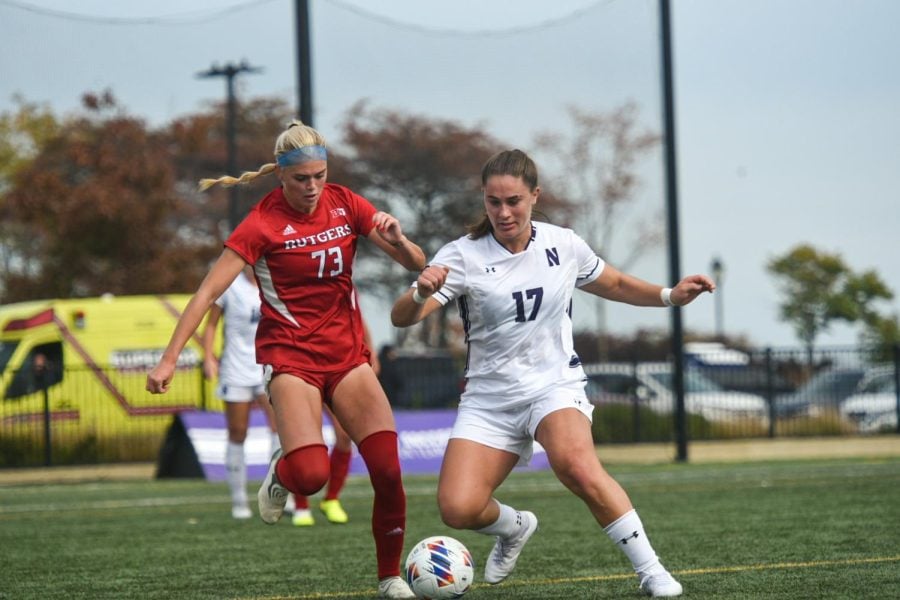Navigating the NIL Landscape: Rowan Lapi’s perspective
Daily file photo by Claudia Arriaga
Senior midfielder Rowan Lapi fends off a Rutgers defender. Lapi capitalized on the new NIL regulations to build her personal brand.
March 1, 2023
There is no shortage of college students posting “a day in the life” vlogs to their YouTube channels. Many incoming Northwestern freshmen watch these videos to get an idea of what their life on campus may look like. This luxury, however, didn’t extend to student athletes until recently.
Senior midfielder Rowan Lapi could not film vlog content about her life as a student-athlete during her first two seasons on the women’s soccer team.
The NCAA enforced strict restrictions barring athletes from receiving compensation beyond athletic and educational scholarships. For decades, the NCAA argued that compensation would nullify the amateurism of collegiate sports that differentiates them from professional sports.
However, in July 2021, following the National Collegiate Athletic Association v. Alston Supreme Court case ruling, the NCAA approved a Name, Image and Likeness policy permitting athletes to receive compensation for use of their personal brand, opening the door for brand partnerships with collegiate athletes.
Lapi said she immediately started reaching out to brands when players were allowed to ink NIL deals.
“At that point, I don’t think I had that many followers either, so I got a lot of free stuff in exchange for a post on my Instagram story,” Lapi said. “I only reached out to people that made sense for me. I would randomly send off DMs, and then people would reach back out.”
Currently, Lapi has long-term partnerships with two brands — Syndacart, a browser extension for online shopping, and a company that uses data to provide fitness and injury assessments to high school and collegiate athletes.
Lapi said shorter-term agreements are also common in the NIL space. Companies like Course Hero have offered compensation — monetary and product — in exchange for sponsored content. Other brands have also reached out to her first and sent product samples.
Lapi posts on social media to let her followers know if she enjoys the products.
“If I really like it, and I like the company and the brand and image that they are cultivating, then I’m down to put them on a story,” Lapi said. “But only if I like it or if I would want my followers to know about it.”
Though a high follower count certainly adds to an athlete’s appeal, brands understand that authenticity is the coin of the realm in social media. When followers trust a user’s recommendations, they are more likely to try a brand’s product or service for themselves.
Lapi has her own litmus test to gauge whether her image aligns with her values.
“I just believe that if you get content and post stuff that is organic, you should be able to look at your past nine posts, and people should be able to get your vibe,” Lapi said, describing what she calls the nine-post test. “It should give a read of who you are. As soon as that’s off track, I’m not doing the right thing.”
Not all athletes have incredibly high follower counts, but players are still uniquely positioned to have substantial influence through what Lapi describes as a network of close ties.
Most student-athletes are mutuals on social media and are also connected with players across the country that they competed with in high school. This web of connections has the potential for widespread reach, according to Lapi.
“I think the network is why brands, especially when this opened up, started going crazy,” Lapi said. “There’s so much potential with this stuff.”
As an aspiring professional player, Lapi is well aware of the pay discrepancies female professional athletes face.
She described how players without financial support from their families have to work second jobs to support themselves while playing their sport. She said cultivating a NIL presence in college may have the potential to alleviate some of these financial burdens in the future.
“These are professional athletes — they shouldn’t have to do that,” said Lapi. “I think that’s the cool thing about NIL in women’s sports. It’s just one more opportunity to let women be professionals in their sport but also make some more money just by doing what they already do.”
Email: [email protected]
Related stories:


